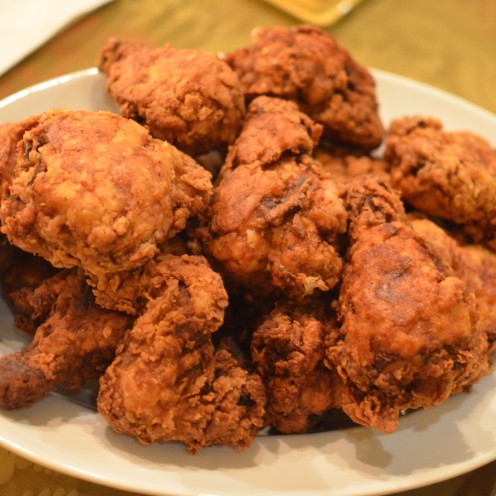ESSENTIAL TIPS FOR MAKING THE BEST FRIED CHICKEN

Making the best fried chicken involves advanced planning, as it is a 2 day process. That's because the key to great fried chicken is first brining the chicken overnight. So, plan ahead and use this recipe for the best fried chicken you will ever taste.
Author: Celia Becker @ www.AfterOrangeCounty.com
Serves: 4
Ingredients
- 1 Whole Fryer Chicken, about 5 lbs, Cut Up (Cut the breasts in half)
- ¼ cup Kosher Salt (for the brine)
- 3 Cups All-Purpose Flour
- 2 Teaspoons Kosher Salt
- 1-1/2 Teaspoons Coarse Ground Pepper
- 3 Cups Buttermilk (whole milk may also be used)
- Canola Oil
Instructions
- Place chicken pieces in a large bowl, fill with enough cold water to cover the chicken, add ¼ cup Kosher salt and give it a quick mix.
- Cover bowl with plastic wrap and place in the refrigerator to soak overnight.
- The following morning remove chicken from refrigerator and drain the salted liquid.
- Line a sheet pan with paper towels and transfer the chicken to the pan.
- Using more paper towels, thoroughly pat each piece of chicken dry.
- Remove the paper towels from the sheet pan and generously salt and pepper (kosher salt & fresh ground pepper is best) each piece of chicken on all sides.
- Add the flour, Kosher salt and pepper to a medium sized mixing bowl and whisk to combine.
- Pour the buttermilk (whole milk may also be used) into a low sided bowl.
- Set up a dredging station by placing the buttermilk, then flour mixture, then paper-towel lined sheet pan in a line from left to right.
- Using 2 hands, one for wet, one for dry ingredients, dredge each piece of chicken in the buttermilk, then in the seasoned flour, pressing down gently so the flour sticks.
- Then it's back into the buttermilk, and finally, back into the flour mixture for a second time.
- If you prefer less breading, dredge the chicken only once.
- Shake off the excess flour and place the chicken on a sheet pan lined with a wire rack which allows any excess flour to collect below the chicken.
- Repeat this process until you have coated all the chicken.
- Cover the sheet pan with plastic wrap and return the tray of chicken to the refrigerator for a minimum of 1 hour. I suggest doing this the morning before you plan to cook the chicken for an evening meal. This step is important because it allows the breading to get wet and sticky, which in turn will produce a crunchy, crispy skin that locks in the moisture and creates a barrier to the absorption of excess grease.
- About 30 minutes before you plan to fry your chicken remove it from the refrigerator and allow it to take some of the chill off.
- Then set up a workstation/assembly line consisting of the tray of chicken, a large frying pan, long tongs and a sheet pan lined with paper towels.
- Into a large, heavy skillet, Dutch oven or cast iron frying pan add about 1 inch of oil.
- Clip a frying thermometer to the side of the pan and heat the oil to 350ºF before adding the first piece of chicken.
- It is important to start with hot oil, otherwise the chicken will absorb the oil and you'll end up with soggy, oily chicken.
- Carefully place about half of the chicken pieces skin side down in the pan using long tongs.
- Fry the chicken in batches so as not to overcrowd the pan.
- The temperature of the oil will drop with the addition of the chicken so adjust the burner to maintain the optimum temperature of 325º F.
- Cook the chicken without turning for about 8 minutes until the chicken is dark golden brown.
- After about 8 minutes turn the chicken over and continue to fry it for an additional 6 to 8 minutes.
- Periodically check the temperature of the oil to insure that it maintains the optimum temperature of 325º F . Adjust the heat as necessary.
- Using an instant read thermometer check the interior temperature of the chicken to determine if it is done. The chicken should be at least 170º F at the thickest part. Dark meat takes longer to cook than white meat. When taking the temperature of the chicken be sure that the tip of your thermometer does not touch the bone, as this will give you a false reading.
- Once the chicken arrives at the desired temperature, remove it from the pan and place it on a prepared sheet pan that has been lined with paper towels to absorb any excess grease.
- Transfer the chicken to a sheet pan lined with a wire rack and place it in the oven or warming drawer, preheated to 200º F to keep the chicken hot while you cook the remaining pieces of chicken.
- Finally, go enjoy the very best fried chicken you will ever taste!
Recipe by After Orange County at http://afterorangecounty.com/2015/02/02/essential-tips-for-making-the-best-fried-chicken/